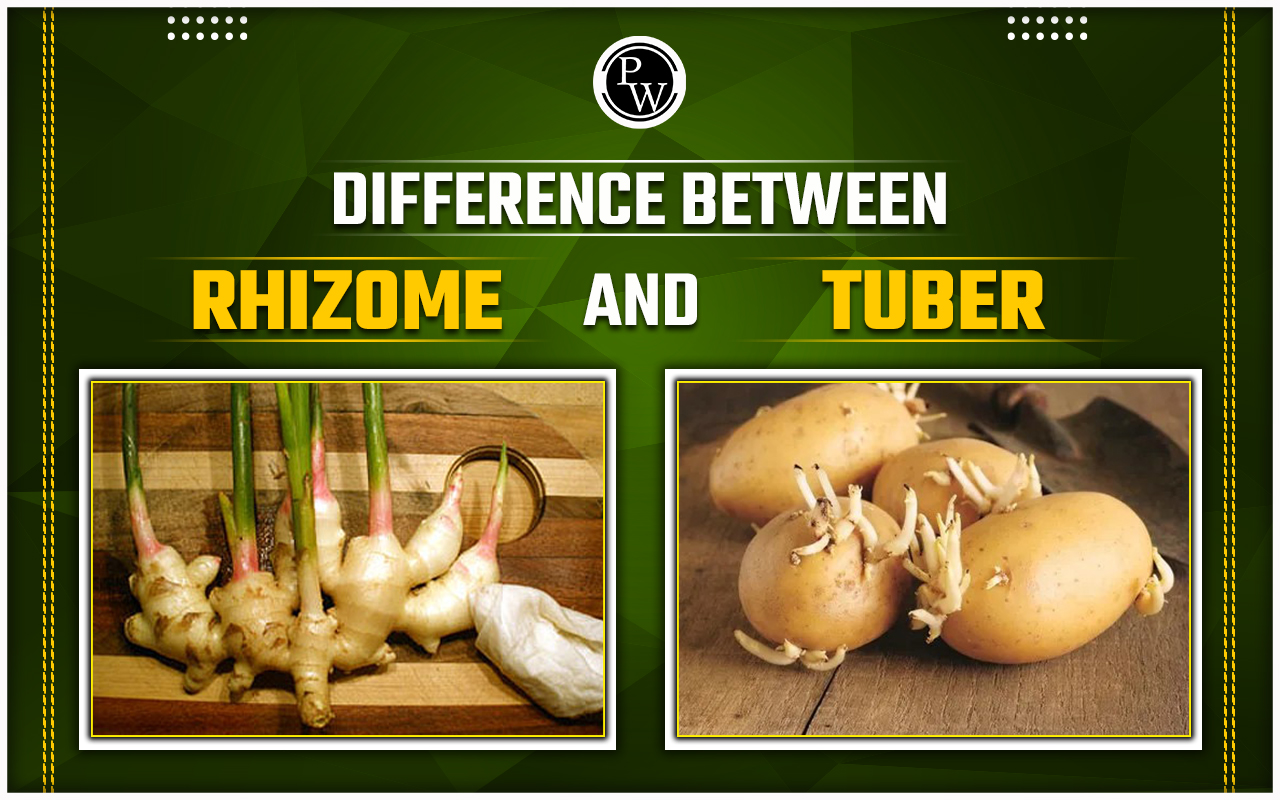

Difference Between Rhizome And Tuber: Growing horizontally beneath the soil are swollen underground stems called rhizomes. Unlike corms or bulbs, tubers don't have a base plant from which new shoots or roots can emerge.
Potatoes, parsnips, and turnips are just a few examples of the many plants that grow underground and are called "root vegetables." While they may all look the same on the surface, root vegetables differ in various ways that occur beneath the soil. Two varieties of root vegetables that are frequently confused are tubers and rhizomes.Related Links -
A rhizome is a modified underground stem of a plant that grows horizontally beneath the soil surface. It typically has nodes from which roots and shoots emerge. Rhizomes can produce new shoots and roots and propagate the plant vegetatively. Tuber: A tuber is a swollen, fleshy underground stem or root that stores nutrients and energy for the plant. Tuberous plants typically store food in their tubers during the growing season and then use it to fuel new growth during the following growing season. Tuberous plants can reproduce both sexually and asexually.Related Links -
Difference Between Rhizome and Tuber
| Characteristics | Rhizomes | Tuber |
| Roots | Horizontal growth within the soil | Its roots are fleshy |
| Stem | The underground stems of rhizomes are thicker. | Modified stems with starchy interiors are called tubers. |
| Offspring | Rhizomes have offspring. | Each year, tubers expand in size. |
| Starch Composition | Starch content in rhizomes is low. | Starch content in tubers is high. |
| Size | Smaller compared to tubers in size | Larger than rhizomes in size. |
| Representative Plant Part | It is the underground stem. | It is the underground modification of the stem. |
| Nodes and Internodes | Have adventitious roots. | There are no roots in the nodes. |
| Growth Habit | Rhizomes expand laterally. | Tubers don't have a structured way of growing. |
| Shape and structure | Rhizomes have an oblong shape. | There is no typical shape for tubers. |
| Types | In rhizomes, dominant classification is not present. | Tubers have two types: stem tubers and root tubers. |
| Shape | Rhizomes are elongated, cylindrical, flattened, typically long and slender. | Tubers are generally round or oblong, with a bulbous or irregular shape. |
| Scales or Sheaths | Rhizomes are typically covered by scales or sheaths, which protect the stem and help it to retain moisture. The scales can be quite small, as in the case of ginger or turmeric, or quite large, as in the case of bamboo. | Tubers have no scales or sheaths. |
| Growth Pattern | Rhizomes grow horizontally just below the soil's surface. They can extend outward from the parent plant and give rise to new plants. | Tubers, on the other hand, can grow at any angle, including vertically. This allows them to access deeper soil layers for nutrients and moisture. |
| Adaptation | Rhizomes are adapted for plants' need to spread quickly and colonise large areas. They are also useful for plants that grow in areas prone to wildfires, as they allow the plant to regenerate rapidly after the fire has passed. | Tubers are adapted for plants that need to store large amounts of energy for survival during drought or other adverse conditions. |
| Reproduction | Rhizomes can reproduce by producing new shoots or buds along their length. This allows the plant to spread and colonise new areas. | Tubers, however, are not typically involved in reproduction. |
| Function | Rhizomes often transport water and nutrients between different plant parts. They can also serve as a food source for animals such as rodents, which eat the stored energy in the rhizomes. | Tubers, on the other hand, are primarily used for storage and survival. |
| Surface Features | Rhizomes often have surface features such as ridges, furrows, or hairs, which help to anchor the plant in the soil and absorb water and nutrients. | Tubers, on the other hand, typically have a smooth surface. |
| Vegetative Propagation, | Rhizomes are commonly used for vegetative propagation, as they can produce new shoots and plants at nodes along their length. This allows gardeners and farmers to propagate plants quickly and easily. | Conversely, Tubers are less commonly used for propagation, as they do not produce new plants directly. |
| Nutrient Content | Rhizomes, on the other hand, are typically lower in nutrients and are used primarily for vegetative growth. | Tubers are typically higher in nutrients than rhizomes, as they are used for storage and survival during times of stress. For example, potatoes are high in potassium, vitamin C, and vitamin B6, while yams are high in fibre, vitamin C, and potassium. |
| Growth Rate | Rhizomes typically grow faster than tubers. This is because rhizomes are involved in the vegetative growth of the plant. As a result, rhizomes can quickly spread and colonise new areas. | Tubers are involved in storage and survival and remain dormant until conditions are favourable for growth. |
| Uses | Rhizomes are used in various ways, including food, medicine, and ornamental plants. For example, ginger is used as a spice and in traditional medicine. At the same time, bamboo is used for construction and furniture making. | Tubers are primarily used as food but also in some industrial processes, such as starch and ethanol production. |
| Examples | Include Bamboo, turmeric, ginger, lotus, asparagus, the Venus flytrap, etc. | Cassava, sweet potatoes, dahlias, oxalis, and begonias. |
Difference Between Rhizome And Tuber <span style=
Describe tubers.
The plant's fleshy storage organ is called a tuber. Each "eye" on the tuber, a collection of depressions called "eye," stands for a node.
Describe rhizomes.
Rhizomes are horizontal underground stems with distinct, fleshy internodes and nodes that are not green in colour. These have a brownish hue and are both auxiliary and apical buds. They are parallel to the ground and have terminal buds.
List some rhizome examples.
Examples of rhizomes include turmeric, asparagus, bamboo, ginger, lotus, and the Venus flytrap.
🔥 Trending Blogs
Talk to a counsellorHave doubts? Our support team will be happy to assist you!

Check out these Related Articles
Free Learning Resources
PW Books
Notes (Class 10-12)
PW Study Materials
Notes (Class 6-9)
Ncert Solutions
Govt Exams
Class 6th to 12th Online Courses
Govt Job Exams Courses
UPSC Coaching
Defence Exam Coaching
Gate Exam Coaching
Other Exams
Know about Physics Wallah
Physics Wallah is an Indian edtech platform that provides accessible & comprehensive learning experiences to students from Class 6th to postgraduate level. We also provide extensive NCERT solutions, sample paper, NEET, JEE Mains, BITSAT previous year papers & more such resources to students. Physics Wallah also caters to over 3.5 million registered students and over 78 lakh+ Youtube subscribers with 4.8 rating on its app.
We Stand Out because
We provide students with intensive courses with India’s qualified & experienced faculties & mentors. PW strives to make the learning experience comprehensive and accessible for students of all sections of society. We believe in empowering every single student who couldn't dream of a good career in engineering and medical field earlier.
Our Key Focus Areas
Physics Wallah's main focus is to make the learning experience as economical as possible for all students. With our affordable courses like Lakshya, Udaan and Arjuna and many others, we have been able to provide a platform for lakhs of aspirants. From providing Chemistry, Maths, Physics formula to giving e-books of eminent authors like RD Sharma, RS Aggarwal and Lakhmir Singh, PW focuses on every single student's need for preparation.
What Makes Us Different
Physics Wallah strives to develop a comprehensive pedagogical structure for students, where they get a state-of-the-art learning experience with study material and resources. Apart from catering students preparing for JEE Mains and NEET, PW also provides study material for each state board like Uttar Pradesh, Bihar, and others
Copyright © 2025 Physicswallah Limited All rights reserved.
Get App











